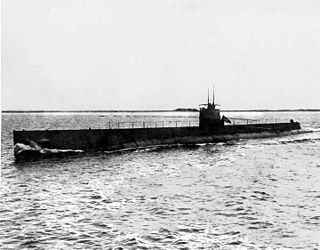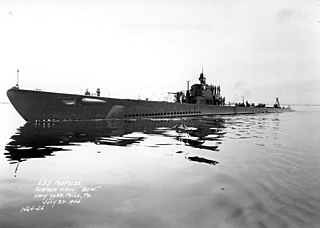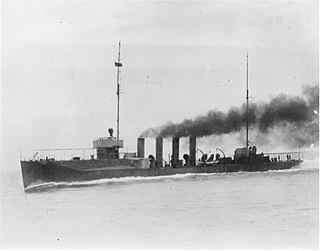
The Gato class of submarines were built for the United States Navy and launched in 1941–1943. Named after the lead ship of the class, USS Gato, they were the first mass-production U.S. submarine class of World War II.

The V-boats were a group of nine United States Navy submarines built between World War I and World War II from 1921 to 1934 under authorization as the "fleet boat" program.

The Plunger class was an early class of United States Navy submarines. In the first years of their service, they were used primarily as training and experimental vessels for the newly formed "silent service" to familiarize naval personnel with the performance and operations of such craft. They were known as the "A class" after being renamed to A-type designations on 17 November 1911. All except Plunger ended up being stationed in the Philippines, an American possession, prior to the outbreak of World War I. They were shipped there on colliers and formed an integral part of the harbor defense system for Manila. In some instances, this class of submarines is referred to as the Adder class, as USS Adder was the first boat of the class to be completed.

USS Adder, later renamed A-2, was one of seven Plunger-class submarines built for the United States Navy (USN) in the first decade of the 20th century.

USS Moccasin (SS-5) was one of seven Plunger-class submarines built for the United States Navy (USN) in the first decade of the 20th century.

USS Barbel (SS-580) was the lead ship of her class of submarines in the United States Navy. She was the second Navy ship named for the barbel, a cyprinoid fish, commonly called a minnow or carp.

The AA-1 class was a class of three experimental submarines of the United States Navy, built toward the end of World War I, between 1916 and 1919, intended to produce a high-speed fleet submarine. The design was not a success and none of the submarines saw active service. However, the lessons learned were applied to the design of the later V-boats. The class was later renamed as the T class.

The Porpoise class were submarines built for the United States Navy in the late 1930s, and incorporated a number of modern features that would make them the basis for subsequent Salmon, Sargo, Tambor, Gato, Balao, and Tench classes. In some references, the Porpoises are called the "P" class.

The United States' S-class submarines, often simply called S-boats, were the first class of submarines with a significant number built to United States Navy designs. They made up the bulk of the USN submarine service in the interwar years and could be found in every theater of operations. While not considered fleet submarines, they were the first submarines in the USN designed for open ocean, blue water operations. All previous submarines had been intended for harbor or coastal defense. These boats were intended to have greater speed and range than previous classes, with improved habitability and greater armament.

USS M-1 (SS-47) was a unique submarine of the United States Navy. Although built as a fully operational boat, M-1 was built with a radically different double-hulled design. This was in marked contrast to Simon Lake's and Electric Boat's single-hulled concepts. Ultimately shown to be unsuccessful, no other submarines of this class were built, although future advances in construction and metallurgy science made the double hull design a standard one for the USN.

USS H-3 (SS-30) was a H-class submarine originally named Garfish, the only ship of the United States Navy named for the gar, a popular target for recreational anglers.

The O'Brien class of destroyers was a class of six ships designed by and built for the United States Navy shortly before the United States entered World War I. The O'Brien class was the third of five classes of destroyers that were known as the "thousand tonners", because they were the first U.S. destroyers over 1,000 long tons (1,016 t) displacement.

The F-class submarines were a group of four submarines designed for the United States Navy by Electric Boat in 1909. F-1 and F-2 were built by Union Iron Works in San Francisco, while F-3 and F-4 were built by The Moran Company in Seattle, Washington.

The B-class submarines were three United States Navy submarines built by the Fore River Shipbuilding Company in Quincy, Massachusetts, under a subcontract from the Electric Boat Company. They were eventually stationed in the Philippines, an American possession, beginning in 1912–15. They were shipped there on colliers. All three were stricken and expended as targets 1919–22.

The C-class submarines were five United States Navy submarines built by the Fore River Shipbuilding Company in Quincy, Massachusetts, under a subcontract from the Electric Boat Company. Built between 1906 and 1909, and in commission from 1908 to 1919, all five were subsequently sold for scrap in 1920. They were considerably larger than the preceding B-class at 275 tons submerged vs. 173 tons submerged, and were the first United States submarines with two-shaft propulsion, doubling the machinery of the B class.

The United States D-class submarines were a trio of submarines built for the United States Navy in the first decade of the 20th century. All three ships served during World War I providing training for crews and officers on the U.S. East Coast, before the class was decommissioned and sold for scrap in 1922.
The G-class submarines were a class of four United States Navy submarines. While the four G boats were nominally all of a class, they differed enough in significant details that they are sometimes considered to be four unique boats, each in a class by herself. They were the result of agitation for competition in submarine design; all previous US submarines were designed by Electric Boat. G-1, G-2, and G-3 were designed by Simon Lake of the Lake Torpedo Boat Company, while G-4 was designed by American Laurenti. G-1 and G-2 were built by Newport News, G-3 by Lake, and G-4 by Cramp.

The E-class submarines were a class of two United States Navy submarines, built by the Fore River Shipbuilding Company of Quincy, Massachusetts, under a subcontract from the Electric Boat Company. They were used as coastal and harbor defense submarines prior to World War I. When hostilities broke out, the E class were mostly used as training boats; however, E-1 operated on war patrols based in the Azores. During this time, the need for an improved permanent bridge structure was discovered; the temporary piping-and-canvas bridges were inadequate in the North Atlantic.

The K-class submarines were a class of eight submarines of the United States Navy, serving between 1914 and 1923, including World War I. They were designed by Electric Boat and were built by other yards under subcontracts. K-1, K-2, K-5, and K-6 were built by Fore River Shipyard in Quincy, Massachusetts, K-3, K-7, and K-8 by Union Iron Works in San Francisco, and K-4 by The Moran Company in Seattle, Washington. All were decommissioned in 1923 and scrapped in 1931 to comply with the limits of the London Naval Treaty.

The United States L-class submarines were a class of 11 coastal defense submarines built 1914–1917, and were the most modern and capable submarines available to United States Navy when the country entered World War I. Despite being considered a successful design by the USN, war experience in European waters demonstrated that the boats lacked the range, speed, and endurance to conduct extended patrols in the North Atlantic.




















